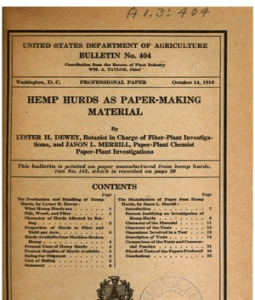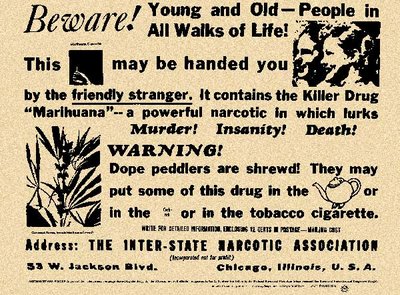Hemp History Line
8000 B.C
Hemp is woven into fabric and grows in popularity over time
on a global scale to eventually provide over 80% of all textiles and fabrics.
4800 B.C
Yangshao culture from this time, used hemp extensively to the extend of decoration. A vase, decorated with hemp cord designs was one of the few evidence.

2700 B.C
Cannabis, as hemp fabric and cordage, medicine, and food,
has been incorporated into virtually all cultures of the Middle East, Asia
Minor, India, China, Japan, and Africa.
2300 B.C.
Nomadic tribes from the East migrate into the Mediterranean
regions and eventually Europe, introducing hemp along the way.
1000 B.C.
Hemp is the world's largest agricultural crop, providing
materials to support civilization's most important industries, including fiber
for fabric and rope, lamp oil for lighting, paper, medicine and food for both
humans and domesticated animals.
Hemp Extracts are the #1, #2, and #3 most important and most
frequently used medicine for two-thirds of the world's population.
500 B.C
Ninety percent of the sailcloth and rigging lines used for
all sea-going vessels is made from hemp. ( including the U.S. ship
'Constitution', better known as 'Old Ironsides'.)
100 A.D.
Chinese discover how to make paper from hemp.
1470's
Gutenberg Bible is printed on hemp paper.
1564
King Philip of Spain mandated the cultivation of hemp for
food, fiber and medicine throughout the Spanish territory in Central and South
America.
1600
Rembrandt paints on hemp canvas.
1611
King James Bible is printed on hemp paper.
1619
America's first hemp law is enacted at Jamestown Colony,
Virginia, ordering all farmers to grow hemp.
1631
'Must grow' hemp laws are enacted throughout Massachusetts.
1631 to early
1800's
Hemp is 'legal tender' and taxes may be paid with hemp
throughout most of the Americas.
 |
| 1914 Federal Reserved $10 note. With the motive of hemp farming printed on hemp paper. |
1632 to mid
`1700's
'Must grow' hemp laws enacted in Connecticut and the Chesapeake
Colonies.
1700
Gainesborough paints on hemp canvas.
1740 - 1940
Russia is the world's largest and 'best quality' producer of
hemp, supplying 80% of Western hemp rope.
1750's
Benjamin Franklin starts one of America's first hemp-rag
paper mills.
1763 - 1767
Farmers who do not grow hemp can be arrested and jailed in
Virginia.
1776
The patriotic populace organizes spinning bees to turn hemp
fiber into clothing for General Washington's Continental Army.
1776
First and second drafts of the Declaration of Independence
are written on hemp paper.
1777
The Stars and Stripes is endorsed as the Capitol Flag of the
U.S.A. and made of hemp fabric.
 |
| Declarion of Independece |
1790's
1800's
Van Gogh paints on hemp canvas.
Australians survive two prolonged famines by using hemp seed
for protein and leaves for roughage.
Hemp seed oil, long the most popular lighting oil in the
world, falls to second place in popularity as whale oil becomes widely
accessible.
The use of hemp extracts as a recreational stimulant spreads
through Western culture and romantic writers expound on individual freedom and
human dignity, extolling cannabis use. Their works include: The Count of Monte
Cristo, The Three Musketeers, Alice in Wonderland, and Through the Looking
Glass.
1812
America goes to war with Great Britain over free-trade
access to Russian hemp.
1837 - 1901
Queen Victoria uses cannabis resins to treat menstrual
cramps, sparking enormous interest in the uses of cannabis as a medicine in the
English- speaking world.
1840
Abraham Lincoln uses hemp-seed oil to fuel his household
lamps.
He also writes ( as a general statement on government
function and legislation ): "Prohibition... goes beyond the bounds of
reason in that it attempts to control a man's appetite by making a crime out of
things that are not crimes... A prohibition law strikes a blow at the very
principles upon which our government was founded."
1842 - 1890
Extracts and derivatives of the hemp plant are the second
and third most prescribed medicines in the U.S.A. Eli Lilly, Parke-Davis,
Squibb, Brothers Smith and other firms produce these medicines through 1930.
During this time, not one death or severe side-effect is recorded as an
attribute to use.
1850
U.S. census records 8,327 hemp plantations of 2,000 acres or
more and an uncalculated number of small hemp farms.
1860
'Ganjah Wallah Hasheesh Candy Company' produces one of the
most popular candies in the U.S. It is made from cannabis derivatives and maple
sugar, sold over-the-counter, and in Sears-Roebuck catalogs. It retains its
popularity as a totally harmless and fun candy for over forty years.
1865
Alice in Wonderland is published on hemp paper.
1870's
The popularity of smoking female cannabis tops, to ease the
back-breaking labor of working sugar cane fields and tolerate the hot sun as
well as to relax recreationally with no alcohol "hang-over", begins
to spread in the West Indies with the immigration of Hindus who are imported to
provide cheap labor. Gradually, this popularity makes its way into the United
States through St. Louis.
1883
Hashish smoking parlors have opened in every major American
city, including an estimated 500 such establishments in New York City alone.
1890's
Popular American 'marriage guides' recommend cannabis
extracts for heightened marital pleasures. Women's temperance groups, lobbying
for alcohol prohibition, suggest cannabis as a suitable substitute for the
'demon drink'.
| A 'hempily' married couple. |
1901 - 1937
U.S. Department of Agriculture predicts repeatedly that with
the advent of machinery capable of harvesting, stripping and separating the
hemp fiber from the pulp, hemp will again be America's "Number One"
crop.
1916
U.S.D.A. publishes Bulletin No. 404, "Hemp Hurds As
Paper-Making Material," extolling and demonstrating the outstanding
qualities of paper manufactured from hemp-pulp, a new process. The document was
printed on hemp-pulp paper and explained the new technology. Previously most
all paper was made with the hemp fiber content of 'rag' (worn out clothing).

1920
To this point in time, U.S. Government papers were written,
by law, on "hempen rag paper".
1929
Henry Ford begins extensive research into the production of
methanol (as a fuel) and the manufacture of plastics from renewable vegetable crops, including hemp.
1935
116 million pounds of hemp seed are used commercially in
America to manufacture paint and varnish.
1937
February uncensored issue of Mechanical Engineering includes the
feature story "The Most Profitable and Desirable Crop That Can Be
Grown" which tells about the new machines being used to harvest hemp.
The Marihuana
Tax Act HR 6385 was enacted; this required a $1 tax stamp on the cultivation of
marihuana and hemp. If somebody wanted to
plant hemp, they would have to buy a tax stamp from the government. The issue
for those in opposition of this tax related to the underhanded manner in which
this tax was enacted. Which means
the government is not giving out any tax stamps. It is said, the government was
in a strict move to illegalize Marijuana. They believe that people who smokes Marijuana are raving, negrito lunatics, that play devils music (jazz), rape white
woman, behaving violently and have the tendency to behave inappropriately, such
as stepping on a white man’s shadow. Anti Marijuana public service films were
made to depict this intolerance behavior. Films like “Reefer Madness”.
Suprisingly, this came after almost 10,000 years if use and hemp is at its
peaking popularity. Of course, the prohibition of hemp and Marijuana did
make a lot of powerful corporation rich. Those thought to gain the most were
Hearst who owned large timber holdings, which feed the paper industry. DuPont
who dominated the petrochemical market, which manufactured plastics, paints,
and other products of fossil fuels and the Secretary of the Treasury and owner
of Gulf oil Andrew Mellon who pushed legislation through congress giving tax
breaks to oil companies. The Conspiracy was against hemp, it threaten certain
vested financial and industrial interest especially those in the paper and
petrochemical industries.
 |
| $1 Marihuana Tax Stamp |
 |
| Public Service about the 'danger' of Marijuana and hemp. |
1938
The February issue of Popular Mechanics runs a story,
(prepared before the 1937 legislation was enacted) titled: "New Billion
Dollar Crop."
1941
December issue of Popular Mechanics features a story on
Henry Ford, showing a picture of the car he "grew from the soil." The
automobile's "plastic panels with impact strength 10 times greater than
steel were made from flax, wheat, hemp, and spruce pulp." The auto weighed
1/3 less than its 100% steel contemporaries.
1942
U.S. government overrides its own ban on hemp and
distributes 400,000 pounds of hemp seed to U.S farmers who produce 42,000 tons
of hemp fiber annually to support the war effort until 1946.
 |
| Posters, to once again encouraging farmers to grow hemp for the war effort. |
U.S. farmers, are
inundated by "Uncle Sam" with incentives to grow hemp. The U.S.D.A.
makes it mandatory for farmers to attend showings of the "Hemp For Victory" film. Farmers and their sons
who agree to grow hemp are exempt from military service, even though America is
at war.
Hemp For Victory
1955
Both hemp and Marijuana are once again banned and declared
illegal. This time the government concluded that smoking Marijuana would make
you a big lazy pacifist. The alleged point was, enemy would use it against the US fighting
troops to supposedly drop their fighting morale. The government now is
illegalizing hemp for the opposite reasons why they banned it first in 1937.
1972
U.S.D.A. finds that hemp seed is lower in saturated fats
than any other vegetable oil (including soybean and canola).
Other studies note that until this century hemp-cake (the
by-product of pressing the seed for oil ) was one of the world's principle
animal feeds.
It is also found that hemp seed, like soybeans, can produce
a tofu-like curd and be spiced to taste like chicken, steak or pork; can be
sprouted for salads, ground into meal, and also made into margarine.
Hemp seed is recommended as a nutritionally balanced food
for domestic pets and farm animals.
1975
Researchers at the Medical College of Virginia discover that
cannabis is incredibly successful for reducing the size of many types of
tumors, both benign and cancerous.
1989
Garments containing hemp fiber are available to the American
public for the first time in over 50 years, however, this clothing must be
imported to the U.S. from China (via Hong Kong) and carries a huge protective
tariff.
1992
Australia
licences hemp farming.
1993
England
eases restriction on hemp farming. News media declare hemp clothes and cannabis
leaf logo hottest new fashion.

1994
Under
the CNCA, one license was granted to a Canadian company, Hempline Inc., to grow
hemp experimentally in Canada under the strict supervision of the authorities.
1996
The
Canadian federal government passed Bill C8 stating that mature hemp stalks are
exemptfrom the list of controlled substances.
1998
The Canadian government legalizes the commercial growth of
industrial hemp.
2012
Israeli Scientist successfully extracted out THC from female Cannabis bud. Resulting to non-psychoactive Medical Marijuana.
Washington & Colorado legalized Marijuana. Adult over the age of 21 can consume & cultivate Marijuana for recreational use without any penalty.
2012
Israeli Scientist successfully extracted out THC from female Cannabis bud. Resulting to non-psychoactive Medical Marijuana.
Washington & Colorado legalized Marijuana. Adult over the age of 21 can consume & cultivate Marijuana for recreational use without any penalty.
Sources
http://www.globalhemp.com/2001/01/hemp-history.html
"Yo momma so old, in her history class, they were writing the history" - Yo Mama Joke
"Yo momma so old, in her history class, they were writing the history" - Yo Mama Joke

No comments:
Post a Comment